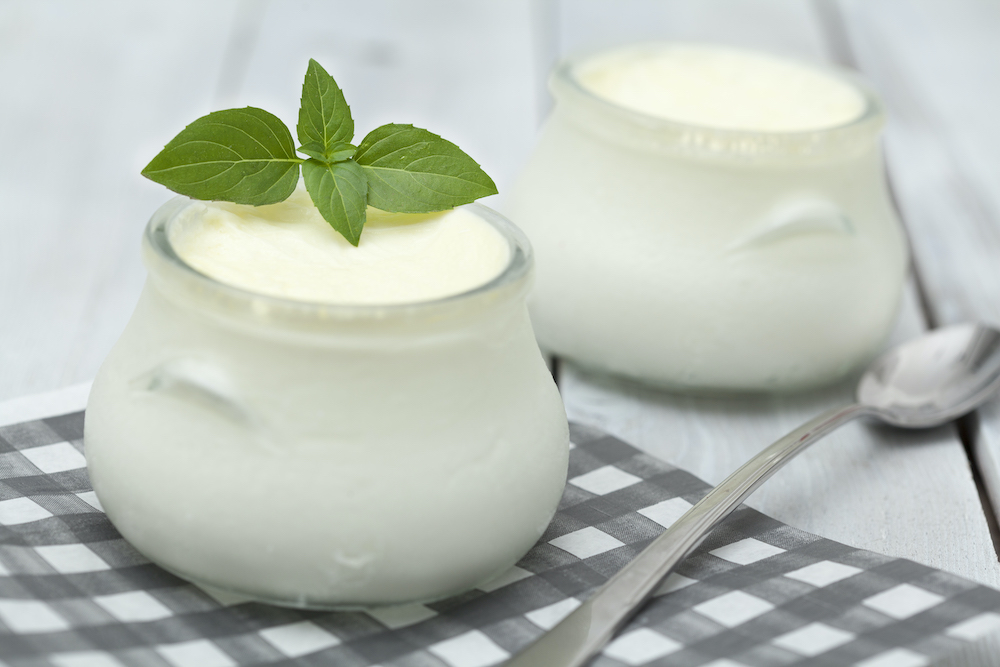 🖨️ Print post
🖨️ Print post
Cultured or fermented dairy products play a role in many traditional cuisines. Yogurt is the fermented milk product with which we are most familiar in the West. It comes originally from Bulgaria. Unlike spontaneously soured milk, yogurt is produced by first heating the milk and then adding a culture. The following recipe comes from the book Nourishing Traditions.
Ingredients
- 1 quart of raw milk
- 3 tablespoons of yogurt — commercial or from previous batch
- 2 teaspoons of yogurt
Instructions
- Place 1 quart of raw milk in a double broiler and heat to 110° F.
- Remove 2 tablespoons of the warm milk and add 1 tablespoon of yogurt, either commercial or from a previous batch.
- Stir well and pour into a quart-sized wide mouth mason jar.
- Add further 2 tablespoons, plus 2 teaspoons of yogurt to the jar and stir well.
- Cover tightly and place in a dehydrator set to 95° F for 8 hours.
- Transfer to the refrigerator.
Notes from Recipe Moderator
Raw milk generally makes yogurt that has a much thinner consistency than yogurt made with pasteurized milk.
One option to address this is to add gelatin to thicken it. Place 4 teaspoons of gelatin into a bowl, and cover it with ¼ cup raw milk until softened. Then whisk the bloomed gelatin into your milk as you heat it to 110° F. Culture normally, and set in the fridge at least 4 hours before serving.
Here is another gelatin recommendation, as well as this one.


I don’t have a dehydrator. Can I make it in my instapot?
We don’t recommend the Instant Pot, however we’ve been told that it does have a yogurt function. Just ensure it isn’t heated above 110° F.
Why do we need to heat raw milk?
So heating it above 110F will lessen its benefits? where as keeping it below 110F would be no different to not heating ??
I tried this a couple of weeks ago with fresh goat milk and the gelatin addition and it turned out nicely. I can set my oven to 100 degrees, so that’s what I used for heating it. (None of my dehydrators are tall enough for a quart jar.) When the eight hours was up, I was a bit concerned because the mixture was still completely liquid. The next morning I was pleased to see it had completely set – almost too much. It was nearly Jello consistency.
This morning I’m using the remainder of that batch for a second batch. This time, I halved the gelatin amount as a test. Since my milk was fresh out of the goat and already at 95 degrees, I just put it in jars in the oven at 110 degrees to get it to temp. In a couple of hours, I’ll reduce the heat and see how it works this time around.
If you don’t have a dehyrdrator that will work for ripening, you can try putting the jar on a heating pad, in a warming drawer, or even in a cooler with a warm water bottle or just warm water. Of course you’ll need to check temps as you go along to make sure you’re in the ballpark, but these are alternatives I’ve known people to successfully use for yogurt.
I’ve used several of the incubation methods listed above. When using the cooler, I’ve found a combination of water bath AND several jars of water works nicely. The water bath is easiest method for large MASS to keep temp steady and the jars provided an easy way to regulate temp if you need to add some warmth during incubation.
With putting them in the oven, did you put it in a water bath? I also don’t have a tall enough dehydrator.
How long can we keep yogurt in the refrigerator to use as a starter for the next batch?
I made a couple of batches of raw yogurt and some I accidentally heated too high, so I had to take it above 180 and let it cool.
I have these batches in the fridge. There is raw yogurt. Then there is raw yogurt in the IP for 24 hours to eat up the lactose. Then theres the heated to 180 yogurt. I have jars of each left and it’s been months. Some jars have actually frozen and been in the garage fridge over winter. How long can these yogurts be good for? Would smell and taste alone tell me if its a spoiled sour and not just a fermented sour?
How long does raw milk yogurt stay “good” in the ref?
I have been following a recipe from a youtube channel where you heat the milk to 185 then cool to 120, add 1 cup yogurt for 4 quarts, mix and pour into mason jars and then put in a cooler with some hot water in the bottom and leave overnight. It has worked great, but I wonder if they’re only taking it to 185 because they’re using pasteurized milk. Since I use raw milk, I wonder if I should just take it to 110. I wonder if taking it to 185 kills beneficial bacteria in raw milk. and I also wonder if taking it to just 110, would the same process still work.
Can I use whey as a starter from a previous batch of homemade yogurt and how long can I keep whey until the next batch?